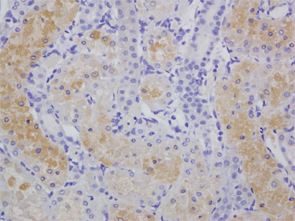anti-Hexanoyl-Lys [HEL], mAb (5F12)
Product Code:
JAI-MHL-021P
JAI-MHL-021P
Antibody Isotype:
Mouse IgG1kappa
Mouse IgG1kappa
Antibody Clonality:
Monoclonal
Monoclonal
Antibody Clone:
5F12
5F12
Regulatory Status:
RUO
RUO
Target Species:
Human
Human
Applications:
- Enzyme-Linked Immunosorbent Assay (ELISA)
- Immunohistochemistry (IHC)
- Western Blot (WB)
Shipping:
BLUE ICE
BLUE ICE
Storage:
-20°C
-20°C
No additional charges, what you see is what you pay! *
| Code | Size | Price |
|---|
| JAI-MHL-021P-20ug | 20 ug | £178.00 |
Quantity:
Prices exclude any Taxes / VAT
Stay in control of your spending. These prices have no additional charges to UK mainland customers, not even shipping!
* Rare exceptions are clearly labelled (only 0.14% of items!).
* Rare exceptions are clearly labelled (only 0.14% of items!).
Multibuy discounts available! Contact us to find what you can save.
This product comes from: Switzerland.
Typical lead time: 10-14 working days.
Contact us for more accurate information.
Typical lead time: 10-14 working days.
Contact us for more accurate information.
- Further Information
- Documents
- References
- Related Products
- Show All
Further Information
EClass:
32160000
Form (Short):
liquid
Formulation:
Lyophilized. Contains 10mM PBS (pH7.4), 5% sucrose, 1% BSA and 0.05% Procline 950.
Handling Advice:
Avoid freeze/thaw cycles.
Immunogen:
N epsilon hexanoyl-keyhole limpet hemocyanin (HEL-KLH).
Long Description:
Monoclonal Antibody. Recognizes Hexanoyl-Lys adducts. Does not cross-react with MDA, glyoxal, methylglyoxal, 1-hexanal, 2-hexenal, 1-nonannal, 2-nonenal, 4-hudroxy-2-nonenal. Lyophilized. Contains 10mM PBS (pH7.4), 5% sucrose, 1% BSA and 0.05% Procline 950. Oxidative damage to lipids (lipid peroxidation) has been found to play an important role in various disease and aging processes. During early stages of lipid peroxidation, lipid hydroperoxides (LOOH) are formed. These can react additionally to form later stage end products such as malondialdehyde (MDA) and hydroxynonenal (HNE). LOOH is measured to quantify early stage or acute lipid peroxidation while MDA is commonly measured to quantify late stage or chronic lipid peroxidation. More recently, it has been reported that 13-hydroperoxyoctadecanoic acid (13-HPODE), a precursor to 13-hydroxyoctadecanoic acid (13-HODE) can react with proteins to form measurable adducts by covalently binding to specific amino acid residues. The Hexanoyl-Lysine (HEL) adduct is formed upon oxidative modification of omega-6 fatty acids such as linoleic acid, the predominant polyunsaturated fatty acid (PUFA) in the human diet, and arachidonic acid. HEL may be another useful biomarker for detecting and quantifying the earlier stages of lipid peroxidation.
Package Type:
Plastic Vial
Product Description:
Oxidative damage to lipids (lipid peroxidation) has been found to play an important role in various disease and aging processes. During early stages of lipid peroxidation, lipid hydroperoxides (LOOH) are formed. These can react additionally to form later stage end products such as malondialdehyde (MDA) and hydroxynonenal (HNE). LOOH is measured to quantify early stage or acute lipid peroxidation while MDA is commonly measured to quantify late stage or chronic lipid peroxidation. More recently, it has been reported that 13-hydroperoxyoctadecanoic acid (13-HPODE), a precursor to 13-hydroxyoctadecanoic acid (13-HODE) can react with proteins to form measurable adducts by covalently binding to specific amino acid residues. The Hexanoyl-Lysine (HEL) adduct is formed upon oxidative modification of omega-6 fatty acids such as linoleic acid, the predominant polyunsaturated fatty acid (PUFA) in the human diet, and arachidonic acid. HEL may be another useful biomarker for detecting and quantifying the earlier stages of lipid peroxidation.
Specificity:
Recognizes Hexanoyl-Lys adducts. Does not cross-react with MDA, glyoxal, methylglyoxal, 1-hexanal, 2-hexenal, 1-nonannal, 2-nonenal, 4-hudroxy-2-nonenal.
Transportation:
Non-hazardous
UNSPSC Category:
Primary Antibodies
UNSPSC Number:
12352203
Use & Stability:
Stable for at least 3 years after receipt when stored at -20°C. After reconstitution, prepare aliquots and store at -20°C.
Documents
References
Preparation of a monoclonal antibody to N(epsilon)-(Hexanonyl)lysine: application to the evaluation of protective effects of flavonoid supplementation against exercise-induced oxidative stress in rat skeletal muscle: Y. Kato, et al.; BBRC 274, 389 (2000) [Development and characterization of anti-HEL monoclonal antibody] | Immunohistochemical detection of oxidative stress biomarkers, dityrosine and N(epsilon)-(hexanoyl)lysine, and C-reactive protein in rabbit atherosclerotic lesions: Y. Fukuchi, et al.; J. Atheroscler. Thromb. 15, 185 (2008) [Application to rabbit atherosclerotic lesions] | A water-soluble fullerene vesicle alleviates angiotensin II-induced oxidative stress in human umbilical venous endothelial cells: R. Maeda, et al.; Hypertens. Res. 31, 141 (2008) [Application to cultured cells (HUVECs)] | Differential Effects of High Glucose and Methylglyoxal on Viability and Polyol Metabolism in Immortalized Adult Mouse Schwann Cells: K. Sango, et al.; Open Diabetes J. 1, 1 (2008) [Application to cultured cell from mouse]
Related Products
| Product Name | Product Code | Supplier | |||||||||||||||||||||||||||||||||||||||||||||||||||||||||||||||||||||||||||||||||||||||||||||||||
|---|---|---|---|---|---|---|---|---|---|---|---|---|---|---|---|---|---|---|---|---|---|---|---|---|---|---|---|---|---|---|---|---|---|---|---|---|---|---|---|---|---|---|---|---|---|---|---|---|---|---|---|---|---|---|---|---|---|---|---|---|---|---|---|---|---|---|---|---|---|---|---|---|---|---|---|---|---|---|---|---|---|---|---|---|---|---|---|---|---|---|---|---|---|---|---|---|---|---|---|
| anti-Acrolein [ACR], mAb (5F6) | JAI-MAR-020N | JaICA | Summary Details | ||||||||||||||||||||||||||||||||||||||||||||||||||||||||||||||||||||||||||||||||||||||||||||||||
| anti-Acrolein [ACR], mAb (5F6) | JAI-MAR-100N | JaICA | Summary Details | ||||||||||||||||||||||||||||||||||||||||||||||||||||||||||||||||||||||||||||||||||||||||||||||||
| anti-Dibromo-tyrosine [DiBrY], mAb (3A5) | JAI-MBY-020P | JaICA | Summary Details | ||||||||||||||||||||||||||||||||||||||||||||||||||||||||||||||||||||||||||||||||||||||||||||||||
| anti-Crotonaldehyde [CRA], mAb (82D3) | JAI-MCA-030N | JaICA | Summary Details | ||||||||||||||||||||||||||||||||||||||||||||||||||||||||||||||||||||||||||||||||||||||||||||||||
| anti-Dityrosine [DT], mAb (1C3) | JAI-MDT-020P | JaICA | Summary Details | ||||||||||||||||||||||||||||||||||||||||||||||||||||||||||||||||||||||||||||||||||||||||||||||||
| anti-4-Hydroxy-2-hexenal [4-HHE], mAb (HHE53) | JAI-MHH-030N | JaICA | Summary Details | ||||||||||||||||||||||||||||||||||||||||||||||||||||||||||||||||||||||||||||||||||||||||||||||||



